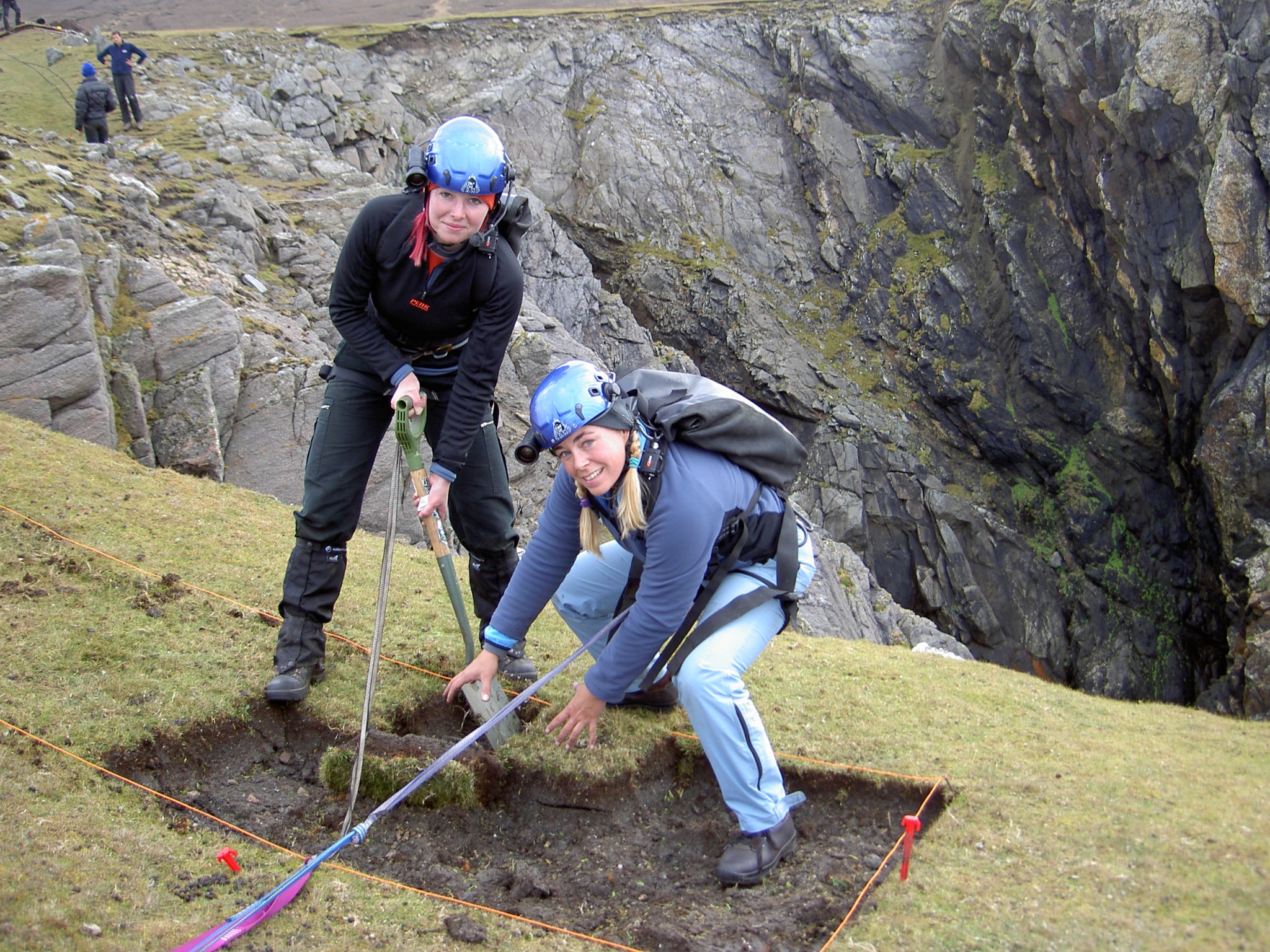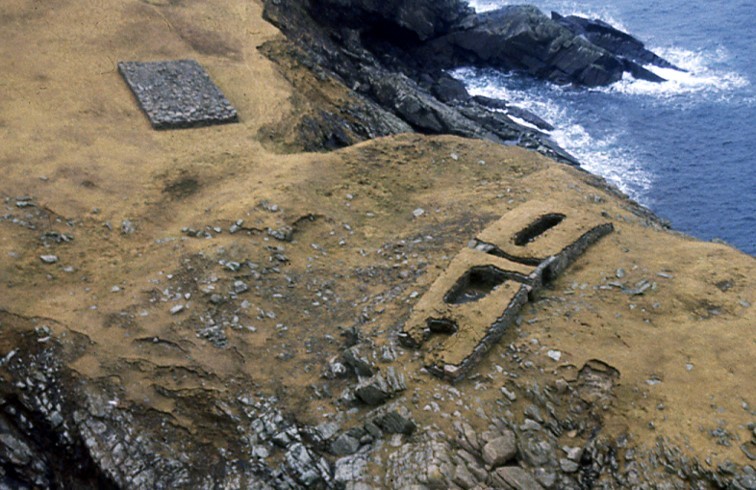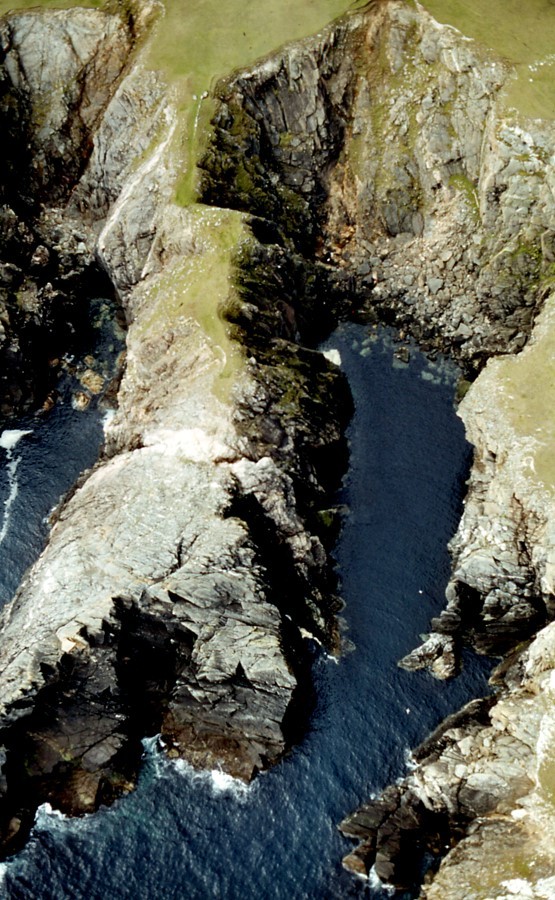Off the Beaten Track 2 - Ness of Burgi
Published: 03 April 2020
The Government advice has changed since last week, and driving long distances to go for a walk is now discouraged. However, one of the glories of Shetland’s archaeology is that it survives so well across the islands that nowhere is very far from remains worth visiting. This week, instead of suggesting a single walk, I am suggesting a few examples of an often overlooked type of site. Until the lock down ends, why not visit the one which is nearest to you?
The Iron Age was a troubled time and most people, not unreasonably, identify it with broch building. Yet brochs were not the only type of defensive site. There were numerous Iron Age promontory forts throughout Shetland. These all had massive banks which either cut off a ness (promontory) or defended the access to an island. At about half a dozen of these sites, the huge bank protects a rectangular block built in stone, known to archaeologists as a “Blockhouse fort”. The best known is the strange looking, and somewhat reconstructed, masonry block which you arrive at first when visiting Clickhimin broch. There are others scattered across the islands, from Fair Isle to North Yell. Landberg, the Fair Isle example, is the only site I know of which was excavated (around 1990) due to being “threatened by puffins” which were burrowing into it.
There were once three forts at the southern tip of mainland Shetland. One, at Sumburgh Head, was reported by George Low in 1774 who observed “a ditch and strong wall … [and] the foundation of a large house, which probably served as a guardroom … and the marks of numerous small buildings …” All that survives today is a single section of the banks and ditch. Most of the site disappeared when the Lighthouse was built a few years after Low’s visit. We had hoped to discover more when the Lighthouse was restored recently but , to our dismay, we found that the remains of Low’s Iron Age buildings were already gone.
However, the Scatness peninsula, opposite, is well worth exploring. This is an easy 1 km walk from the end of the public road at Scatness – that is, until you get to the site itself.

The Ness of Burgi is attached to the mainland by a narrow path which crosses a natural arch of rock. Historic Environment Scotland has erected a hand rail to help people get there safely. Once across, you will find yourself on a flat grassy area. Just before you reach the peninsula, defended with a substantial ditch, bank and second ditch, there is a neat rectangular platform of stone. Don’t be fooled. This was built by archaeologists, after the excavations, as a way of disposing of the stone they had removed from the fort. In fact the blockhouse may have stood to twice its current height, based on the amount of stone.
 The blockhouse is drystone built, and has a low tunnel or passageway through the middle. Some of the massive roofing slabs are still in place. Half way along the passage, on the left, is a doorway which opens into a long beehive-shaped (corbelled) room, interpreted as a guard cell. There are two further rooms or “cells” on the right hand side. The entrance to these is from the seaward side. The most complete cell is also partly roofed, and excavations in 1935 showed that there had been two hearths here, used at different times. In contrast, the third cell is very ruinous.
The blockhouse is drystone built, and has a low tunnel or passageway through the middle. Some of the massive roofing slabs are still in place. Half way along the passage, on the left, is a doorway which opens into a long beehive-shaped (corbelled) room, interpreted as a guard cell. There are two further rooms or “cells” on the right hand side. The entrance to these is from the seaward side. The most complete cell is also partly roofed, and excavations in 1935 showed that there had been two hearths here, used at different times. In contrast, the third cell is very ruinous.
The masonry doesn’t go all the way across the peninsula and the excavators found no trace of buildings on the seaward side, either here or at Tonga. That isn’t proof that there weren’t any, but it does raise some intriguing questions about how the blockhouses were used - and indeed how they related to brochs. I think that the blockhouses look rather like flattened, or stretched out, brochs. Whilst that might be a clue, it is still a mystery as to whether blockhouses were earlier, later, or contemporary with the brochs.
 Burgi Geos, Yell (HP 4782, 0338) is spectacular. To get there, take the track from Gloup and follow Gloup Voe inland. At the head of the voe, turn right (west) and head across the moorland to the coast. It is quite rough going under foot.
Burgi Geos, Yell (HP 4782, 0338) is spectacular. To get there, take the track from Gloup and follow Gloup Voe inland. At the head of the voe, turn right (west) and head across the moorland to the coast. It is quite rough going under foot.
The place name, meaning “broch or fortified geos”, says it all. Long ago the sea carved out two geos, leaving a promontory between them. Iron Age people then defended the landward side with a ditch. The approach to this site is particularly curious. On the northern side the path is edged by a line of stone, but on the southern side there is a collection of jagged stones on end, set into a mound, looking rather like teeth. Although archaeologists have likened this to a chevaux de fries - a portable line of spikes used as a defence against cavalry - the stones are not across the entrance but alongside it. Perhaps it was intended to help prevent visitors from falling off. Once across the path, you are confronted by a wall with a mound behind. Beyond this there are traces of what may have been round huts. Channel 4 filmed an episode of “Extreme Archaeology” here. Their excavations were minimal but revealed a hearth with a complete, but squashed, Iron Age pot. The archaeologists in that programme were roped to a central point, not entirely for the benefit of the cameras, so do take care.
In case none of these sites is particularly close to where you live, I hope to have further suggestions next week. Wherever you walk, stay safe and stay away from others just now.
Regional Archaeologist, Val Turner of Shetland Amenity Trust, 3 April 2020
We hope you have enjoyed this blog.  We rely on the generous support of our funders and supporters to continue our work on behalf of Shetland. Everything we do is about caring for Shetland's outstanding natural and cultural heritage on behalf of the community and for future generations. Donations are welcomed and are essential to our work.
We rely on the generous support of our funders and supporters to continue our work on behalf of Shetland. Everything we do is about caring for Shetland's outstanding natural and cultural heritage on behalf of the community and for future generations. Donations are welcomed and are essential to our work.

